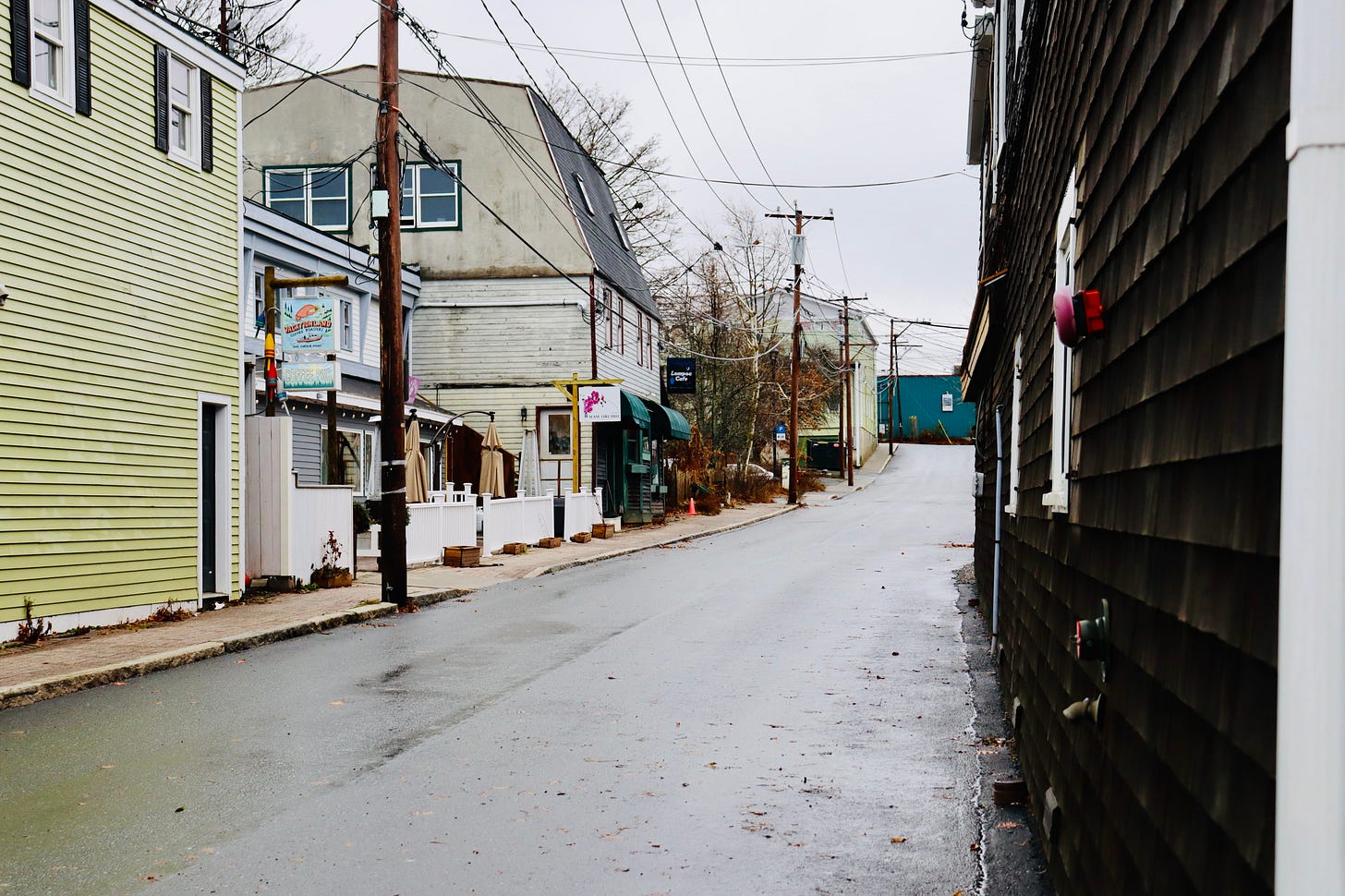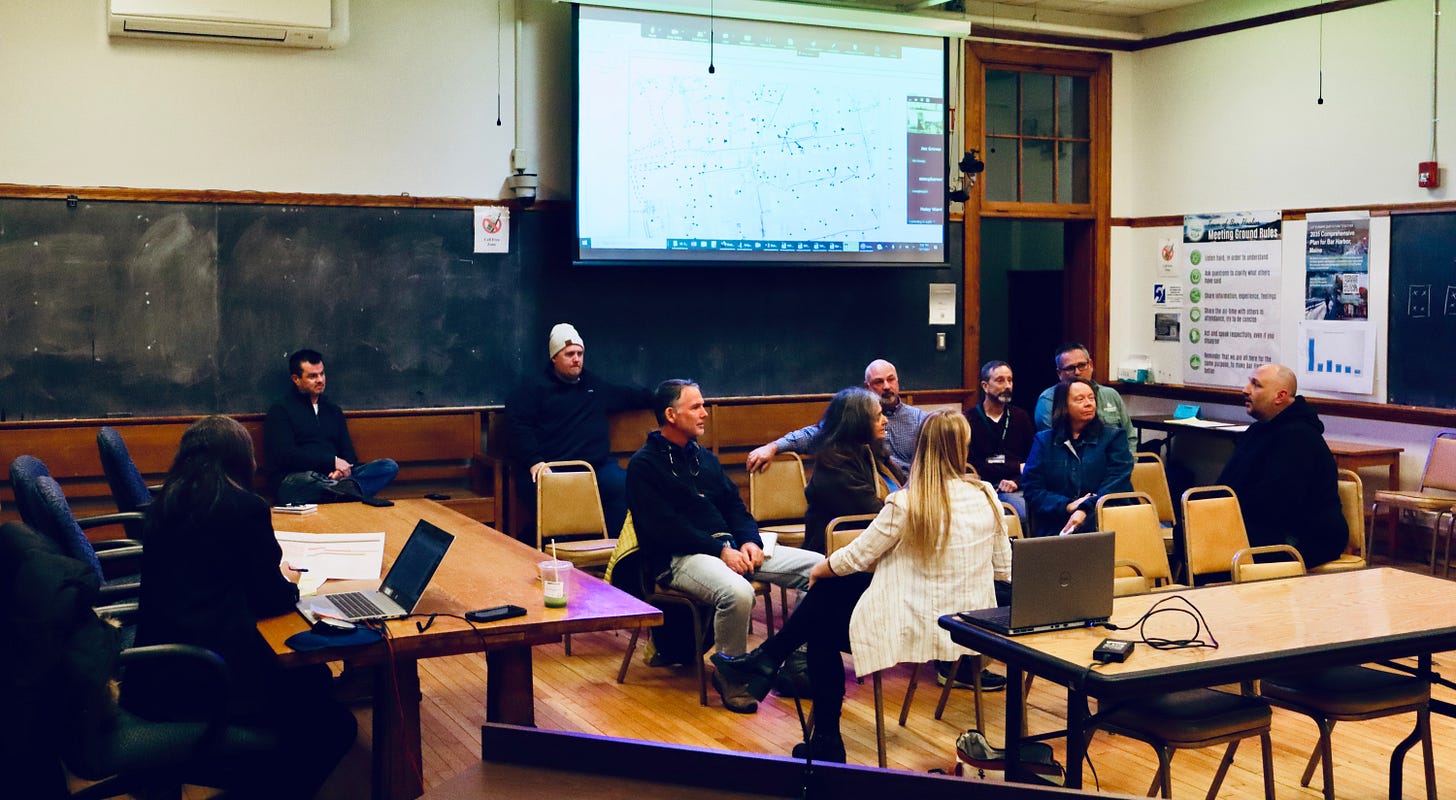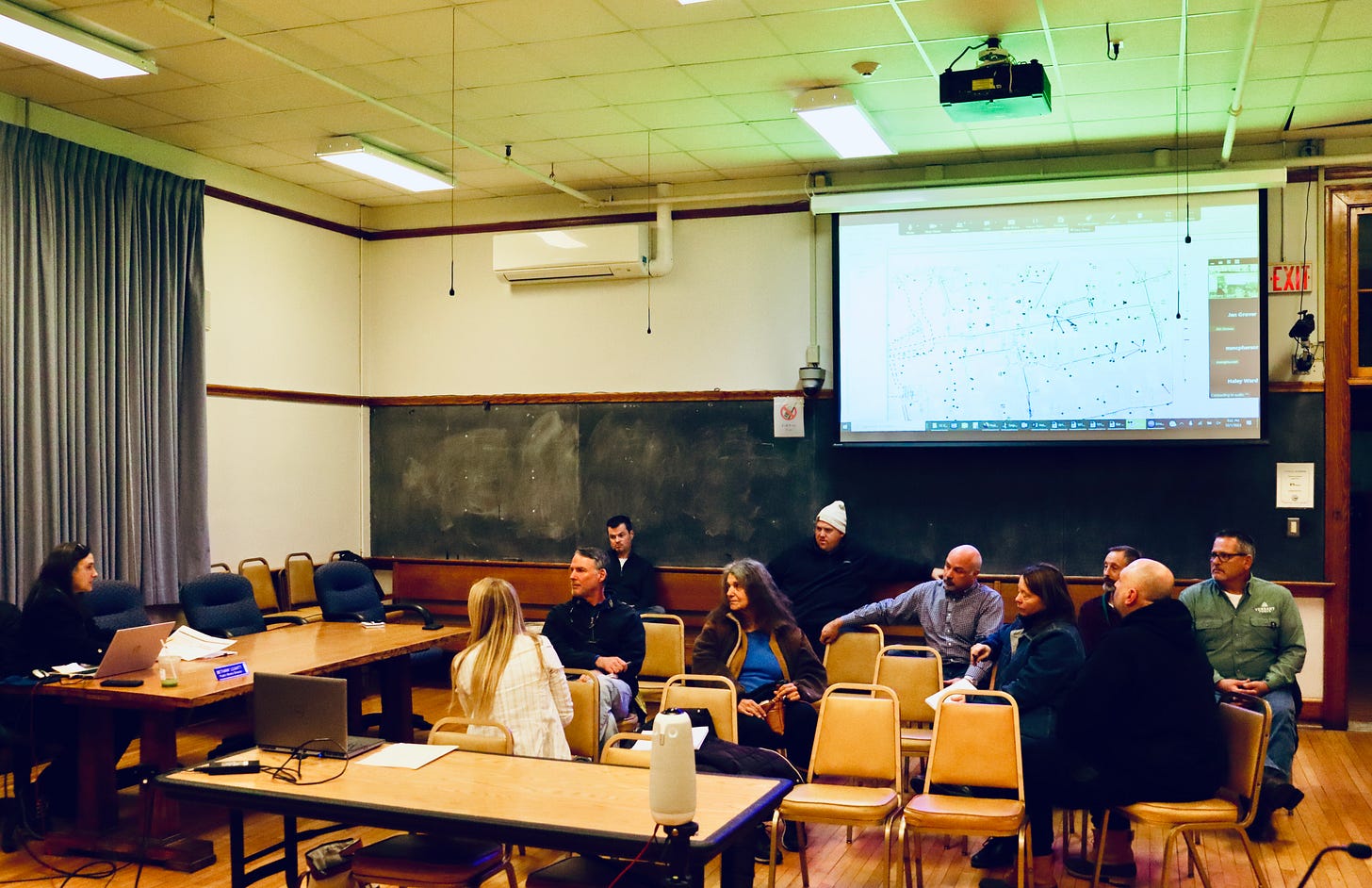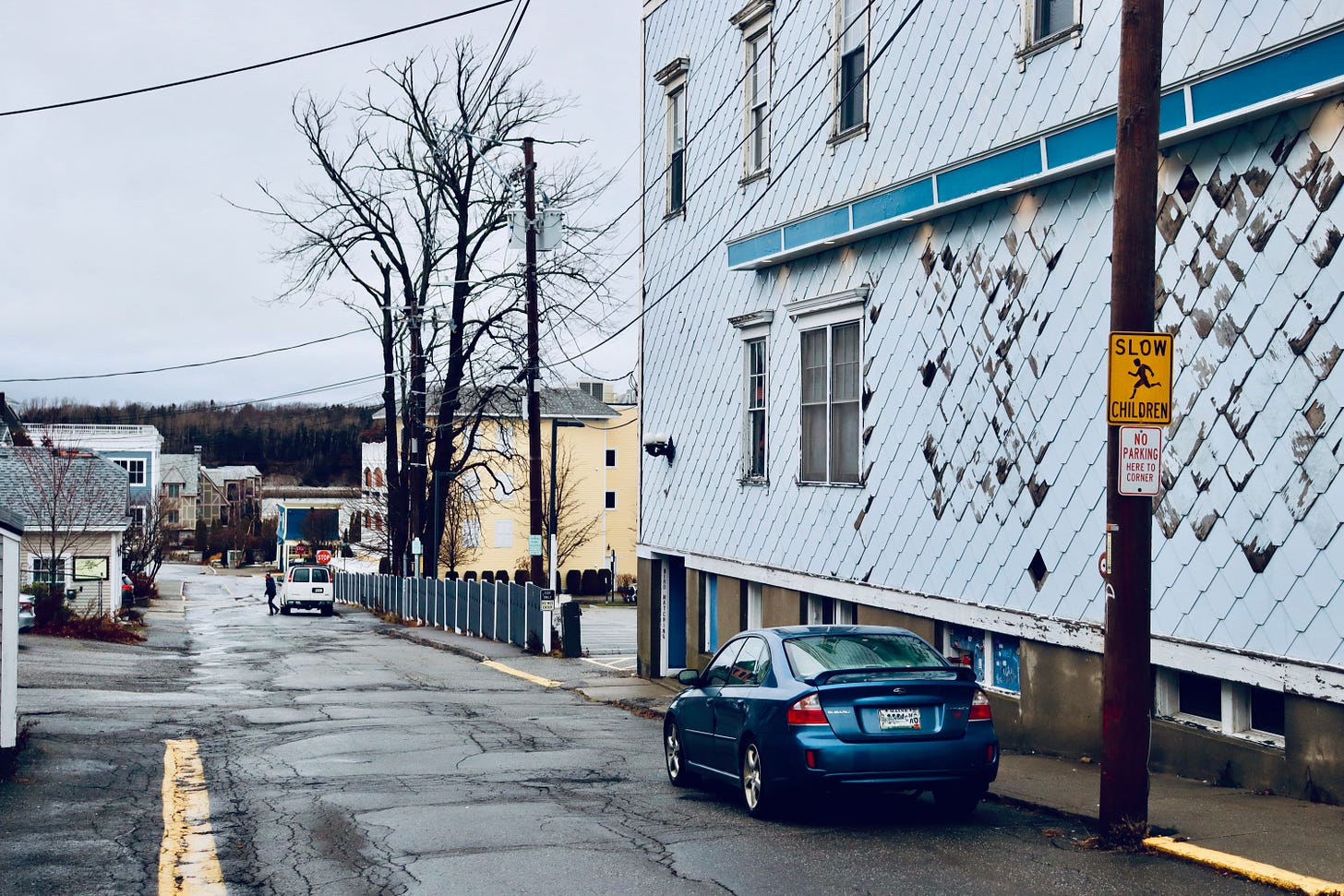Ten-Foot-Wide Sidewalk Might Be Coming to Part of One Downtown Street
Work would likely be in 2025 tourist season
BAR HARBOR––Six property owners or their representatives gathered in the Town Council chambers and one online via Zoom, Thursday night to hear a presentation given by Director of Public Works Bethany Leavitt regarding the preliminary planning stages of a potential switch to underground utilities on Rodick Street. The neighborhood meeting was called so that residents and business owners could have a chance to ask questions about the potential upcoming project and for the town to gauge property owners’ interest in pursuing it.
Lower Rodick Street already has underground utilities from West Street to York Avenue. This work was done during the construction of the West Street Hotel. The remainder of the street has telephone poles servicing a few remaining customers on the west side of Rodick and these poles would interfere with the town’s planned 10-foot-wide sidewalk on the east side of the street.
The town already has plans to upgrade the water and stormwater systems on lower Rodick Street as well as the replacement and upgrade of a forced main.
Once the project discussion began, the idea of expanding the sidewalk and creating a pedestrian thoroughfare as an alternative to Main Street was brought up, according to Leavitt. In order to make a clean pedestrian way, the utility poles would have to be removed.
The meeting was also attended by Justine Drake of Haley Ward, the engineering consultants, Buddy Greenlaw of Versant Power, Kevin Wagner of Versant Power, Ken Miller, an electrical engineer of Versant Power, and Mike McPherson of Consolidated Communications via Zoom.
PROJECT IMPACT
This extra wide sidewalk would also mean the loss of all on street parking for the lower section of Rodick Street from Cottage Street to York Avenue. The remaining 20-foot-wide travelway would still be one way from Cottage Street to York Avenue.
Switching to underground utilities for the remainder of the customers on lower Rodick Street would necessitate the installation of aboveground transformers, fuses, and switch boxes. These would require a concrete pad which would sit on a currently undetermined piece of property somewhere on the east side of the road.
Upper Rodick Street would not include the accompanying underground infrastructure work with the exception of a possible stormwater issue that needs to be addressed. The idea for this section of Rodick Street is to remove as many utility poles as possible so that the sidewalk can be redone. In that portion of the street, the width of the sidewalk would not be changed, but it would be flattened out and made more user friendly.
There is much less known about the project on upper Rodick Street at this time because it is not known if it would be both primary and secondary power that would be placed underground or just the primary. Primary power refers to the supply lines that typically run pole to pole. Secondary power would be the section of line that leaves the pole and runs to any individual building.
Some secondary power lines are owned by the property owner. This means the owner is responsible for paying Versant Power or an electrician, or both, if anything happens to the secondary power line. The same holds true for underground power. The customer is responsible for anything from the “vault” to the house. Secondary powerline ownership occurs if there is a private pole (or an underground vault) between a Versant Power-owned pole and the property being serviced.
Versant Power utilizes a “private line and service contract” to ensure that property owners are aware of and understand their responsibilities in regard to the secondary power line feeding their property, whether it is above ground or underground. Consolidated Communications does not have these private line agreements but would require a right of way at some points to facilitate the installation of above ground pedestals from which it would distribute individual service lines. These pedestals cannot go underground because of moisture sensitivity issues.
Putting just primary underground on upper Rodick Street would not eliminate the need for utility poles. This part of the project would also require a concrete pad for transformers, fuses, and switch boxes. This pad has been potentially located in the first three parking spaces of the two middle rows of public parking in the Old Police Department parking lot. These three parking spaces would be eliminated.
According to Miller, the utilities would run underground from behind the West Street Hotel up lower Rodick Street to the pad holding the transformers, fuses, and switch boxes then back under the street to the west side to underground boxes called vaults, where the utilities would then be split to individual houses. The lines from those vaults to each individual property would be the responsibility of the property owners as far as any necessary repairs in the future are concerned because they are secondary power lines.
It has not been determined who would be responsible for paying for the initial installation of the secondary underground lines, said Leavitt. She said that she has to research how the town has handled that in the past.
Any upgrades or enhancements necessary to facilitate the switch to underground service rather than overhead service on each individual building are also the responsibility of the property owner. This could include a new entrance/meter box if the current one does not accept a feed from below or if it is too old or compromised in some way.
THE PROJECT’S ULTIMATE GOAL
Leavitt said that the ultimate goal would be to remove all utility poles along lower Rodick Street and upper Rodick Street up to the point where the new concrete pad would be in the Old Police Department parking lot. That is dependent on whether or not both primary and secondary service on upper Rodick Street can be moved underground. From the point of the new concrete pad holding the transformers, fuses, and switch boxes to Firefly Lane would still be overhead service with poles until that section could be done as a separate phase.
There are buildings that do not sit on Rodick Street that are serviced and would continue to be serviced from the point where the concrete pad would sit in the Old Police Department parking lot and this is why it would have to be a separate phase of construction to remove the poles to the south on Rodick Street.
Miller said that he hopes that section can be moved underground sometime in the future because the poles that reside next to the apartment building that sits at the corner of Rodick Street and Kennebec Place/Firefly Lane are within code requirements but are closer to the building than Versant would like.
There was some talk about servicing some lower Rodick Street buildings from the Federal Street poles. Miller said that this would be dependent on the capacity of the Federal Street system and whether or not the buildings have an existing rear service entrance. If a building does not have an existing rear service entrance, it can be costly for the property owner to upgrade the building’s electrical system to install one.
Additionally, there was conversation regarding servicing some upper Rodick Street customers from Kennebec Street but this would be highly unlikely because it would require right of ways across property lines and some of the businesses on upper Rodick Street use two and three phase power. A normal residence uses single phase power.
POTENTIAL PROJECT TIMING
Many of the attendees voiced concern about when the lower Rodick Street construction would be taking place because regardless of the potential underground utility work, the town’s infrastructure work will take a long period of time. Patrick Fogarty said that prior to having a business and residence on lower Rodick, he and his wife had no idea what a major pedestrian thoroughfare it is and while they love the idea of wider sidewalks, no on street parking, and no telephone poles, they would prefer the road not be torn up during the tourist season.
“What is the timeline on it?” Side Street Café General Manager Bo Jennings asked. “I guess, that’s the total length of time for the project.”
Leavitt said that the timing of the project depends on how quickly everything progresses from this point, but it would be ideal to start next fall and work over the winter. However, she stressed that this is still very preliminary and there are many pieces of the puzzle still missing, so she cannot give any sort of firm timeline.
Disruption of both vehicular and pedestrian traffic on lower Rodick Street was also a concern. Miller explained that when the town’s infrastructure work is being done, the underground utility work will also be completed as far as vaults, conduits, etc. This will allow the actual connection of the power to the buildings to take place after the road construction in more of a phased approach.
Jennings continued to press for a construction method that was something more than just eight hours a day and then everyone goes home, saying that an extended project that makes either end of Rodick inaccessible will kill businesses.
Leavitt agreed and said that they want to take a more expedient approach to the construction but also stated that she has put projects out to bid with special requests and failed to get any bids back. She told the audience that they should be prepared for work to be happening on lower Rodick Street during the tourist season of 2025.
An email to both Leavitt and Finance Director Sarah Gilbert regarding projected costs or financing options for this project were not answered as of press time.










